九年级英语第一单元教案
- 格式:doc
- 大小:73.50 KB
- 文档页数:27
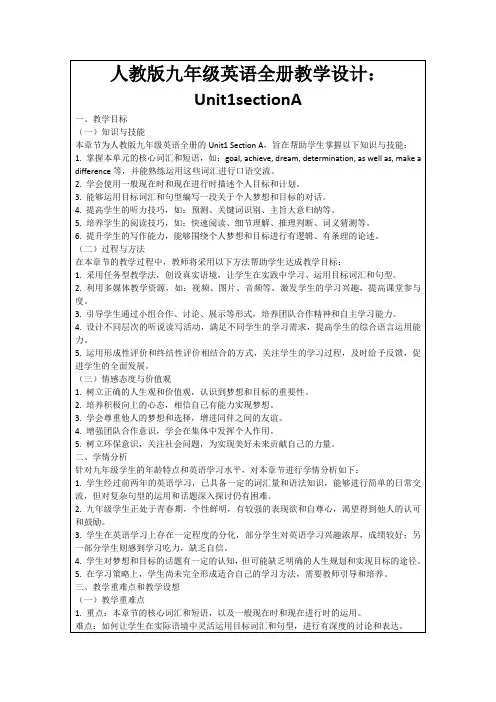

仁爱英语九年级上册教案第一单元《Unit 1 School Life》
Section A
课前预
- 了解课文标题和主题,预测词汇和短语
- 预并理解课文中的单词和句型
- 思考与课文主题有关的问题和话题
听力训练
- 听取录音,熟悉课文内容和结构
- 提高听力技巧和技能,学会提取有关的信息和思路语言训练
- 学会运用课文中的单词和短语
- 研究和运用课文中的语法和句型
- 培养表达和交流能力
阅读训练
- 带着问题和目的阅读课文
- 研究和应用相关的词汇和表达方式
- 提高理解能力和速度,发掘文本信息和意义
口语训练
- 学会流畅自然地表达和交流
- 练在不同情境和话题中表达自己的看法和意见- 提高语音语调和语言语法的正确性和准确性
Section B
课前预
- 基于课文主题和问题,了解背景知识和文化积累
- 预和掌握课文中的关键词语和短语
- 预测和推断课文中可能存在的问题和解决办法
听力训练
- 听取录音,熟悉和理解课文内容和结构
- 学会听懂和提取课文中的关键信息,筛选和转述有关的内容语言训练
- 学会运用课文中的单词和短语
- 学会运用和灵活掌握课文中的语法和句型
- 培养表达和交流能力,学会表达自己的看法和观点
阅读训练
- 带着问题和目的阅读课文,理解和概括文本意思和主旨
- 研究和应用相关的词汇和表达方式,提高辨析和推断能力- 提高阅读速度和效率,积累阅读和背景知识
口语训练
- 学会流畅自然地表达和交流,掌握一定的语言技巧和技能- 练在不同情境和话题中表达自己的看法和意见
- 提高语音语调和语言语法的正确和准确。
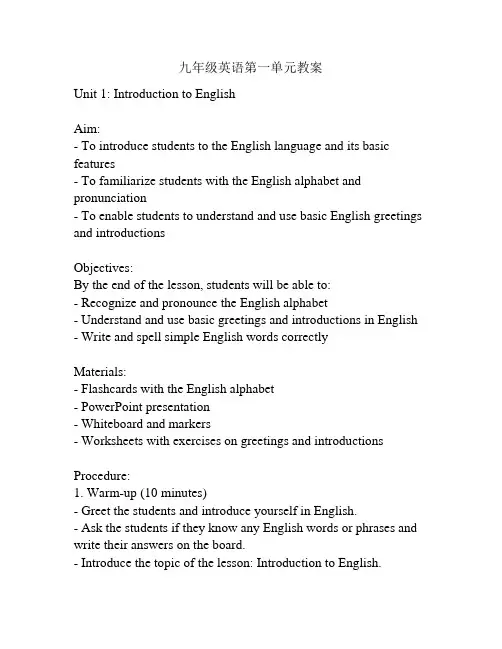
九年级英语第一单元教案Unit 1: Introduction to EnglishAim:- To introduce students to the English language and its basic features- To familiarize students with the English alphabet and pronunciation- To enable students to understand and use basic English greetings and introductionsObjectives:By the end of the lesson, students will be able to:- Recognize and pronounce the English alphabet- Understand and use basic greetings and introductions in English - Write and spell simple English words correctlyMaterials:- Flashcards with the English alphabet- PowerPoint presentation- Whiteboard and markers- Worksheets with exercises on greetings and introductions Procedure:1. Warm-up (10 minutes)- Greet the students and introduce yourself in English.- Ask the students if they know any English words or phrases and write their answers on the board.- Introduce the topic of the lesson: Introduction to English.2. Presentation (15 minutes)- Show the flashcards with the English alphabet and pronounce each letter clearly. Ask the students to repeat after you.- Present the pronunciation of each letter using examples of words that start with that letter.- Use the PowerPoint presentation to show images of objects and animals starting with each letter of the alphabet. Ask the students to guess the word.- Write the words on the board and ask the students to spell them out loud.3. Practice (20 minutes)- Divide the students into pairs or small groups.- Distribute the worksheets with exercises on greetings and introductions.- Ask the students to read each dialogue and complete the missing words using the given options.- Monitor the students' progress and provide assistance if needed.4. Group Activity (15 minutes)- Divide the students into small groups.- Ask each group to come up with a short dialogue of greetings and introductions.- Encourage the students to use the English alphabet and the vocabulary learned in the previous exercises.- Give the groups a few minutes to prepare their dialogues, and then ask them to perform in front of the class.5. Wrap-up (5 minutes)- Review the key points of the lesson: the English alphabet,greetings, and introductions.- Ask the students to summarize what they have learned today. - Answer any questions the students may have.6. Homework- Assign the students to practice writing simple English words using the alphabet.- Ask them to write a short paragraph introducing themselves in English.Note: The duration of each activity may vary depending on the students' level and the pace of the lesson. It is important to gauge their understanding and adjust accordingly.。
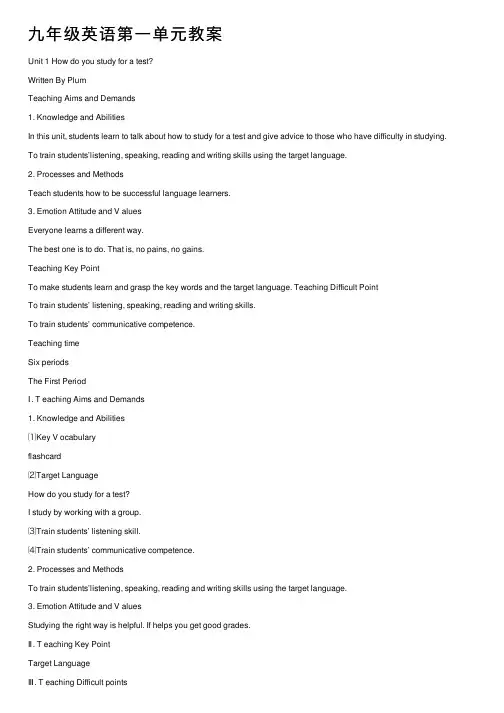
九年级英语第⼀单元教案Unit 1 How do you study for a test?Written By PlumTeaching Aims and Demands1. Knowledge and AbilitiesIn this unit, students learn to talk about how to study for a test and give advice to those who have difficulty in studying. To train students’listening, speaking, reading and writing skills using the target language.2. Processes and MethodsTeach students how to be successful language learners.3. Emotion Attitude and V aluesEveryone learns a different way.The best one is to do. That is, no pains, no gains.Teaching Key PointTo make students learn and grasp the key words and the target language. Teaching Difficult PointTo train students’ listening, speaking, reading and writing skills.To train students’ communicative competence.Teaching timeSix periodsThe First PeriodⅠ. T eaching Aims and Demands1. Knowledge and Abilities⑴Key V ocabularyflashcard⑵Target LanguageHow do you study for a test?I study by working with a group.⑶Train students’ listening skill.⑷Train students’ communicative competence.2. Processes and MethodsTo train students’listening, speaking, reading and writing skills using the target language.3. Emotion Attitude and V aluesStudying the right way is helpful. If helps you get good grades.Ⅱ. T eaching Key PointTarget LanguageⅢ. T eaching Difficult points1. Train students’ listening skill.2. Train students’ communicative competence.Ⅳ.Teaching procedures1、对照课前准备的内容,在班⾥举办⼀个⾃由访谈,向你认为英语成绩优异的同学请教⼀下学习⽅法,或者把你的经验告诉其他同学。
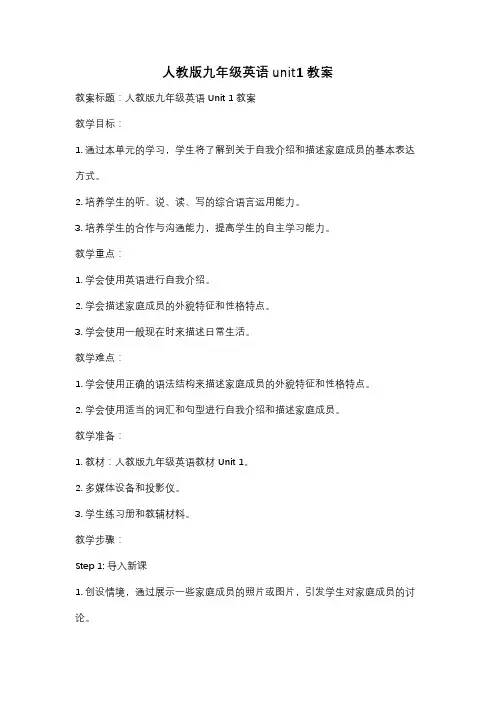
人教版九年级英语unit1教案教案标题:人教版九年级英语 Unit 1 教案教学目标:1. 通过本单元的学习,学生将了解到关于自我介绍和描述家庭成员的基本表达方式。
2. 培养学生的听、说、读、写的综合语言运用能力。
3. 培养学生的合作与沟通能力,提高学生的自主学习能力。
教学重点:1. 学会使用英语进行自我介绍。
2. 学会描述家庭成员的外貌特征和性格特点。
3. 学会使用一般现在时来描述日常生活。
教学难点:1. 学会使用正确的语法结构来描述家庭成员的外貌特征和性格特点。
2. 学会使用适当的词汇和句型进行自我介绍和描述家庭成员。
教学准备:1. 教材:人教版九年级英语教材 Unit 1。
2. 多媒体设备和投影仪。
3. 学生练习册和教辅材料。
教学步骤:Step 1: 导入新课1. 创设情境,通过展示一些家庭成员的照片或图片,引发学生对家庭成员的讨论。
2. 引导学生回忆和使用一些基本的英语句型来描述家庭成员,如"He has short hair. She is tall."Step 2: 学习新知1. 向学生介绍本单元的目标和重点,并给出相关的词汇和句型。
2. 使用多媒体设备展示相关的图片和例句,帮助学生理解和掌握新知识。
3. 学生跟读和模仿老师的发音和语调。
Step 3: 合作学习1. 将学生分成小组,让他们互相介绍自己和自己的家庭成员。
2. 鼓励学生使用本单元学到的句型和词汇来进行描述,老师可以提供必要的帮助和指导。
Step 4: 个人练习1. 学生个别完成练习册中的相关练习,巩固所学内容。
2. 教师巡视课堂,及时纠正学生的错误并给予指导。
Step 5: 拓展活动1. 让学生在家中进行采访,了解家庭成员的更多信息,并准备一份简短的报告。
2. 学生可以利用多媒体设备和投影仪展示自己的采访成果。
Step 6: 总结和评价1. 教师与学生一起回顾本节课所学的内容,并进行总结。
2. 教师给予学生积极的评价和鼓励,鼓励他们在日常生活中多使用英语进行交流。
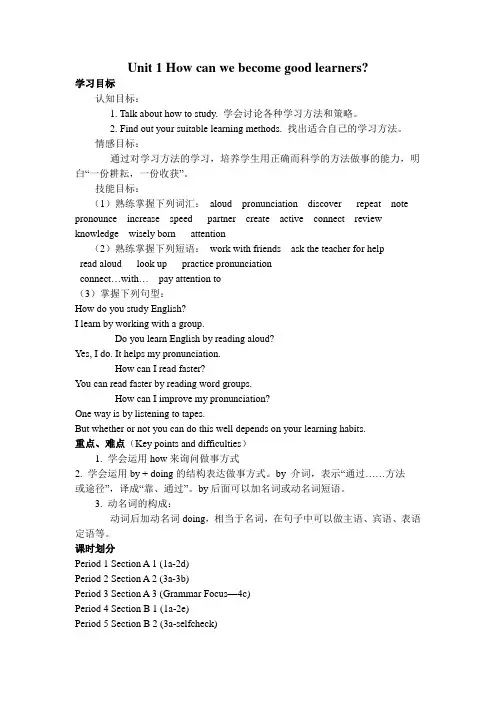
Unit 1 How can we become good learners?学习目标认知目标:1. Talk about how to study. 学会讨论各种学习方法和策略。
2. Find out your suitable learning methods. 找出适合自己的学习方法。
情感目标:通过对学习方法的学习,培养学生用正确而科学的方法做事的能力,明白“一份耕耘,一份收获”。
技能目标:(1)熟练掌握下列词汇:aloud pronunciation discover repeat note pronounce increase speed partner create active connect review knowledge wisely born attention(2)熟练掌握下列短语:work with friends ask the teacher for helpread aloud look up practice pronunciationconnect…with…pay attention to(3)掌握下列句型:How do you study English?I learn by working with a group.Do you learn English by reading aloud?Yes, I do. It helps my pronunciation.How can I read faster?You can read faster by reading word groups.How can I improve my pronunciation?One way is by listening to tapes.But whether or not you can do this well depends on your learning habits.重点、难点(Key points and difficulties)1. 学会运用how来询问做事方式2. 学会运用by + doing的结构表达做事方式。
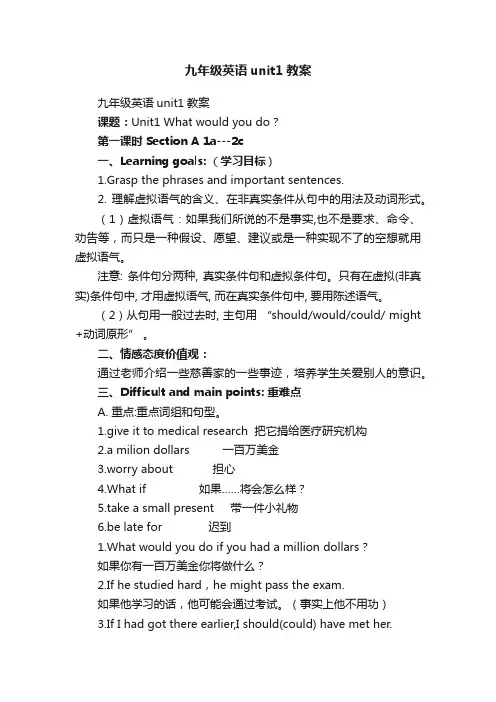
九年级英语unit1教案九年级英语unit1教案课题:Unit1 What would you do?第一课时 Section A 1a---2c一、Learning goals: (学习目标)1.Grasp the phrases and important sentences.2. 理解虚拟语气的含义、在非真实条件从句中的用法及动词形式。
(1)虚拟语气:如果我们所说的不是事实,也不是要求、命令、劝告等,而只是一种假设、愿望、建议或是一种实现不了的空想就用虚拟语气。
注意: 条件句分两种, 真实条件句和虚拟条件句。
只有在虚拟(非真实)条件句中, 才用虚拟语气, 而在真实条件句中, 要用陈述语气。
(2)从句用一般过去时, 主句用“should/would/could/ might +动词原形” 。
二、情感态度价值观:通过老师介绍一些慈善家的一些事迹,培养学生关爱别人的意识。
三、Difficult and main points: 重难点A. 重点:重点词组和句型。
1.give it to medical research 把它捐给医疗研究机构2.a milion dollars 一百万美金3.worry about 担心4.What if 如果……将会怎么样?5.take a small present 带一件小礼物6.be late for 迟到1.What would you do if you had a million dollars?如果你有一百万美金你将做什么?2.If he studied hard,he might pass the exam.如果他学习的话,他可能会通过考试。
(事实上他不用功)3.If I had got there earlier,I should(could) have met her.如果我早点到那儿,我就会见到她。
(事实上,我去晚了。
)4.If he would come here tomorrow,I should(would)talk to him.如果他明天来这儿的话,我就跟他谈谈!B. 难点:(1)语法:虚拟语气的含义、在非真实条件从句中的用法及动词形式四、Teaching Steps:教学步骤Step 1:One minute talk. 一分钟对话,考察学生的口语表达能力。
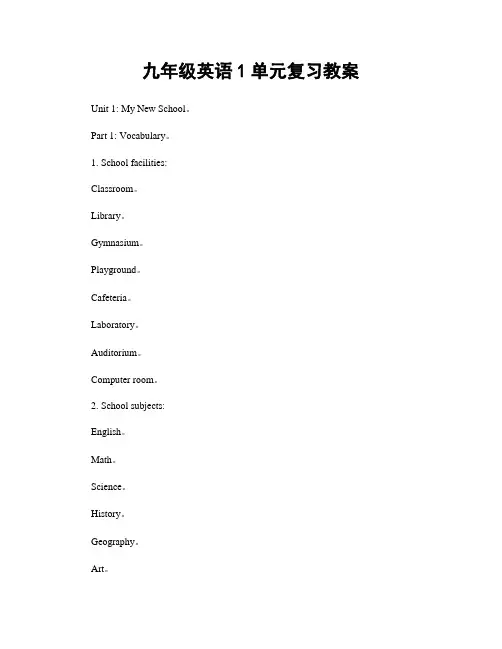
九年级英语1单元复习教案Unit 1: My New School。
Part 1: Vocabulary。
1. School facilities:Classroom。
Library。
Gymnasium。
Playground。
Cafeteria。
Laboratory。
Auditorium。
Computer room。
2. School subjects:English。
Math。
Science。
History。
Geography。
Art。
Music。
Physical Education。
3. School supplies:Pen。
Pencil。
Eraser。
Ruler。
Notebook。
Textbook。
Calculator。
Backpack。
Part 2: Grammar。
1. Present simple tense:Affirmative: I go to school every day. Negative: I don't like math. Interrogative: Do you study English?2. Prepositions of place:The library is next to the cafeteria.The gymnasium is opposite the playground. The classroom is on the second floor.3. Adjectives and adverbs:She is a good student.He runs quickly.The test was really difficult.Part 3: Reading and Writing。
1. Reading comprehension:Read the passage about a new school and answer the questions.2. Writing skills:Write a paragraph about your new school, including the facilities, subjects, and your favorite part of the school.Part 4: Speaking and Listening。
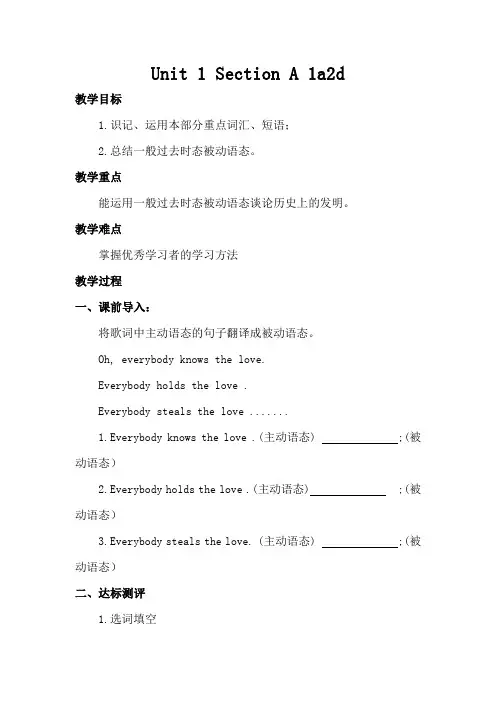
Unit 1 Section A 1a2d教学目标1.识记、运用本部分重点词汇、短语;2.总结一般过去时态被动语态。
教学重点能运用一般过去时态被动语态谈论历史上的发明。
教学难点掌握优秀学习者的学习方法教学过程一、课前导入:将歌词中主动语态的句子翻译成被动语态。
Oh, everybody knows the love.Everybody holds the love .Everybody steals the love .......1.Everybody knows the love .(主动语态) ;(被动语态)2.Everybody holds the love .(主动语态) ;(被动语态)3.Everybody steals the love. (主动语态) ;(被动语态)二、达标测评1.选词填空Practice develop remember prepare take notes until worry about everythingAre you stressed out each time you have a test? You don’t have to be if you __________smart study skills. Remember to________________ in class and review them on your own or with friends after class. Then ___________ what you learned by doing exercises. Try to study and _________________ information bit by bit instead of waiting _____________the last minute to study _______________at once. If you _________________well for a test, then there’s nothing to ______________________!2. 根据汉语提示完成英语句子1. 我经常在犯语法错误。
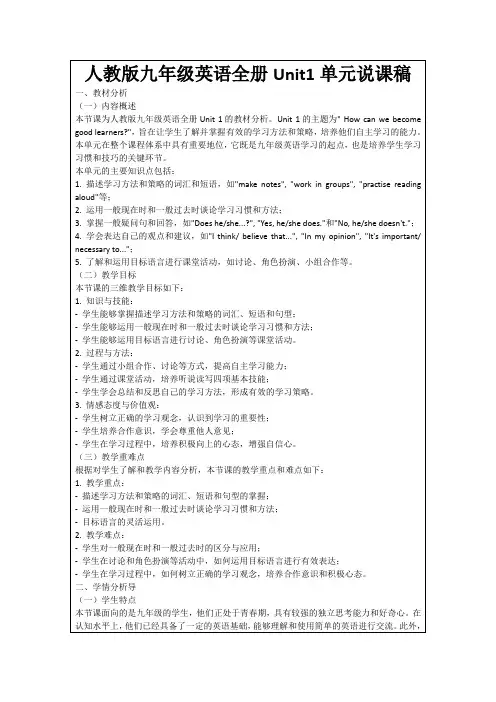
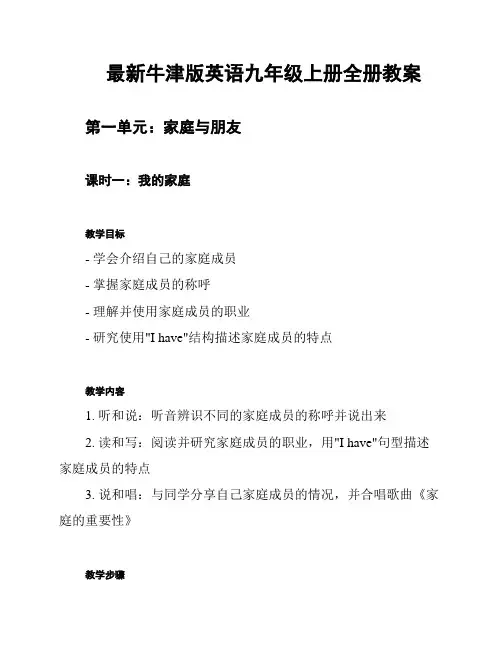
最新牛津版英语九年级上册全册教案第一单元:家庭与朋友课时一:我的家庭教学目标- 学会介绍自己的家庭成员- 掌握家庭成员的称呼- 理解并使用家庭成员的职业- 研究使用"I have"结构描述家庭成员的特点教学内容1. 听和说:听音辨识不同的家庭成员的称呼并说出来2. 读和写:阅读并研究家庭成员的职业,用"I have"句型描述家庭成员的特点3. 说和唱:与同学分享自己家庭成员的情况,并合唱歌曲《家庭的重要性》教学步骤1. 导入:通过自我介绍引入话题,引发学生对家庭的思考2. 听说活动:播放录音,听音辨识家庭成员的称呼,并进行口头练3. 读写练:学生阅读课本材料并复述,然后完成练册上的练4. 说唱练:学生以小组形式分享自己家庭成员的情况,并编排歌曲的合唱动作和分声部演唱5. 温故知新:小结本课内容,鼓励学生复并运用所学知识注意事项- 激发学生研究兴趣,提供多样化的听说读写练- 强调家庭的重要性,鼓励学生了解并尊重家庭成员的职业课时二:我的朋友教学目标- 学会描绘朋友的外貌特征- 能够描述朋友的爱好和特长- 研究运用"What does he/she look like?"和"What is he/she like?"这两种句型教学内容1. 听和说:听音辨识不同的外貌特征并说出来2. 读和写:研究描述朋友的爱好和特长,并研究使用"It's + 形容词"句型3. 说和唱:与同学分享朋友的外貌特征和兴趣爱好,并一起唱歌曲《朋友是什么》教学步骤1. 导入:播放一段表演片段,引发学生对朋友的讨论,让他们提出外貌特征的描述2. 听说活动:通过录音让学生听音并说出描述外貌特征的词语3. 读写练:学生阅读课本材料并复述,根据提示写出朋友的爱好和特长4. 说唱练:学生以小组形式分享自己朋友的外貌特征和兴趣爱好,并进行歌曲的合唱和分声部演唱5. 温故知新:小结本课内容,鼓励学生复并运用所学知识注意事项- 引发学生对朋友的讨论,激发他们描述外貌特征的兴趣- 提供足够的听说读写练,让学生运用句型并巩固所学知识---以上是《最新牛津版英语九年级上册全册教案》第一单元的教学内容和步骤。
完整版)人教版英语九年级Unit1教案设计Unit 1: How to e a Good LearnerXXX:Cognitive Objectives:1.Discuss XXX.2.XXX.Affective Objectives:Through learning about study methods。
students will develop the ability to approach tasks with correct and scientific methods。
and understand the concept of "you reap what you sow."XXX:1.Master the following vocabulary: aloud。
n。
discover。
repeat。
note。
pronounce。
increase。
speed。
partner。
create。
active。
connect。
review。
knowledge。
wisely。
born。
n.2.Master the following phrases: work with friends。
ask the teacher for help。
read aloud。
look up。
practice n。
connect。
with。
pay n to.3.Master the following sentence structures:How do you study English?I learn by working with a group.Do you learn English by reading aloud?Yes。
I do。
It XXX.How can I read faster?You can read faster by reading word groups.How can I XXX?One way is by XXX.However。
九年级英语 unit1 教课方案【篇一:人教版九年级英语上册unit1 教课方案】人教版九年级英语上册教课方案unit 1 how can we become good learners ? 单元计划单元学习目标:1.能写出本单元的常用词汇和要点短语2.能正确运用how 来咨询做事方式,运用by +doing 的构造表达做事方式,3能描绘学习英语的方法,解决英语学习中的一些困难;学会解决生活的问题.单元重难点:1)能正确运用 how 来咨询做事方式,运用 by +doing 的构造表达做事方式,2)能描绘学习英语的方法,解决英语学习中的一些困难;学会解决生活的问题.1.要点词汇和短语大声地 _______ 发音 __________认识到;认识到_________快速地_______责任;义务_________ 影响 _________ 除非 _________ 使感人;使印象深刻_________范错;犯错__________ 此后;随后___________ 没关系___________惧怕去做__________嘲讽___________ 做笔录_____________ 查阅;查找___________ 办理;对付 __________将。
视为_____________生某人的气 _______________(指时间)过去____________全力做。
___________中断;忽然中断 ____________ 假造;构成 _____________结束做某事 _____________ 第一 __________________2.要点句型翻译1)你是如何准备考试的?我和朋友们一同学习。
2)你以前参加过学习小组吗?是的,参加过。
经过这类方式我学了很多。
3)我没有伙伴能够练习英语。
也许,你应当参加一个英语俱乐部。
4)大声朗诵来练习发音怎么样?你为何不参加一个英语俱乐部呢?5)为何你不参加英语俱乐部来练习你的英语呢?6)在老师的帮助下尽最大努力去学习是我们的职责。
人教版初中英语九年级全册《Unit 1 How can we Section B 2a3b 》优质课公开课课件、教案人教版九年级英语unit1复习导学案【复习目标】一、熟练掌握下列词汇: aloud pronunciation discover pronounce create active connect knowledge wisely born attention二、熟练掌握下列短语: ask the teacher for help look up be bornwith connect…with… pay attention to三、掌握下列句型:1. Because I wanted to understand thestory , I looked them up in a dictionary.2. Everyone is born with the ability to learn.3. Studies show that if you are interested in something, your brain is more active and it is also easier for you to pay attention to it for a long time.4. Good learners often connect what they need tolearn with something interesting.【重点、难点】1. 掌握how来询问做事方式。
2.掌握by+doing的结构表达做事方式。
by介词,表示“通过……方法或途径”,译成“靠、通过”。
by后面可以加名词或动名词短语。
3. 动名词的构成:动词后加动名词doing,相当于名词,在句子中可以做主语、宾语、表语定语等。
【知识梳理】1. I ___________ ask questions __________ my poor pronunciation.2. I ____________________________ this exciting and funny movie!3. So I _________________ watch other English movies, too.4. I _________ them ________ in a dictionary.5. I want to learn new words and more grammar so that I can___________________English movies.6. Everyone ___________________ the ability to learn.7. But whether or not you can do this well _________________ your learning habits.8. Research shows that successful learners have some good habits_____________________.9. Studies show that if you are interested in something , your brain is more active and it is also easier for you to ____________________ it for a long time. 10. _____________________ , they may _________________ by__________________ key words or by drawing mind maps.11. They also ___________________ ways to review what they have learned.12. Good learners often _______________ what they need to learn___________ something interesting.13. Knowledge _____________________ questioning.【重难点讲解】1. By asking the teacher for help.介词by 的用法:(1)、表示方式、方法或手段,后接名词或动名词,意为“使用某物;靠;乘(车船)等”。
教案教学目标:1.知识目标:学习掌握单元所涉及的词汇和短语,如numbers, greetings, introductions, countries, nationalities, etc.学会使用正确的句子模式进行自我介绍和问候。
2.能力目标:听、说、读、写与课文有关的表达方式,并能够运用到日常生活中。
系统地阅读并理解课文,并进行简单的语言表达和交流。
3.情感目标:培养学生对英语学习的兴趣,积极的学习态度和团队合作精神。
教学重点:掌握并能灵活运用本单元的词汇和句型进行交流。
教学难点:能够用正确的句子表达自己的姓名、国家和年龄,并能进行简单的问候和回应。
教学过程:Step 1: 问候与自我介绍 (Greetings and introductions)1.翻译以下常用问候语并说出其重要性- Good morning / afternoon / evening.- How are you?- Nice to meet you.- What’s your name?2.教师介绍:- Hi, everyone. I’m Miss Li. What’s your name? Let’s introduce ourselves to each other.-让学生围坐一起,轮流自我介绍。
Step 2: 数字与年龄 (Numbers and ages)1.翻译以下数字-1,2,3,4,5,6,7,8,9,102.使用以下句子进行练习交流:- How old are you? I’m __ years old.- What’s your phone number? My phone number is ______.-学生分组,两两进行操练。
Step 3: 国家与国籍 (Countries and nationalities)1.学习以下国家的名称和国籍:- China, Chinese- America, American- Japan, Japanese- England, English2.使用以下句子进行练习交流:- Where are you from? I’m from ______.- What’s your nationality? I’m ______.-学生分组,两两进行操练。
Unit 1How can we become good learners?12单元话题 Talk about how to study, in this unit, students learn to talk 3about how to study for a test and give advice to those who have difficulties 4in studying.5单元语法By + sth./doing sth.6教学目标71.语言目标:理解重点句子,掌握学习英语的方法。
介词by引导的方式状语8的合理运用。
92.技能目标:正确运用动名词谈论学习中的问题。
103.情感目标:通过开展角色表演等活动,培养学生阅读兴趣。
通过本单元的阅11读,培养学生的文化意识,陶冶思想情操,让学生树立终身学习的道德素养。
121314第一课时Section A(1a~2d)15自主学习案16翻译下列词组。
171.通过制作生词卡 ________________________________182.通过听录音带___________________________________193.向某人寻求帮助__________________________________204 大声读来练习发音___________________________________215.小组合作学习___________________________________226.和朋友练习对话___________________________________237.逐个单词___________________________________248.作报告___________________________________259.意群___________________________________2610.慢慢来___________________________________2711.口语技能___________________________________2812 英语口语___________________________________29§课堂导学案30Step 1 准备与热身(Preparation)31Leadin with a free talk(自由对话导入新课)(2分钟)32Greeting with the students:Hello, everyone.Welcome back to school.I'm 33very happy to see you again.Most of you got good grades last term ! Of 34course, don't lose your heart if you didn't get good grades.35OK.Today, let's talk about how to study for a test and how to learn 36English well.37T: How do you study English? Do you study English by the following ways?38(Show some pictures and present the important phrases.)39T: How do you study English?40S: I study English by ________.41working with friends making word cards42asking the teacher for help reading the textbook43working with a group listening to tapes44Step 2 呈现与输入(Presentation)451.要求学生翻开课本P1,迅速阅读1a部分的内容。
---------------------------------------------------------------最新资料推荐------------------------------------------------------九年级英语第一单元教案学习目标Unit 1 How can we become good learners?认知目标:1. Talk about how to study. 学会讨论各种学习方法和策略。
2. Find out your suitable learning methods. 找出适合自己的学习方法。
情感目标:通过对学习方法的学习,培养学生用正确而科学的方法做事的能力,明白“一份耕耘,一份收获”。
技能目标:(1)熟练掌握下列词汇:aloud pronunciation discover repeat note pronounce increasespeedpartner create active connect review knowledge wisely bornattention (2)熟练掌握下列短语:work with friends ask the teacher for help read aloud look uppractice pronunciation connect…with… pay attention to (3)掌握下列句型:How do you study English? I learn by working with a group.Do you learn English by reading aloud? Yes, I do. It helps my pronunciation.How can I read faster? You can read faster by reading word groups.How can I improve my pronunciation? One way is by listening to tapes.But whether or not you can do this well depends on your learning habits. 重点、难点(Key points and difficulties)1. 学会运用 how 来询问做事方式 2. 学会运用 by + doing 的结构表达做事方式。
by 介词,表示“通过……方法或途径”,译成“靠、通过”。
1/ 27by 后面可以加名词或动名词短语。
3. 动名词的构成:动词后加动名词 doing,相当于名词,在句子中可以做主语、宾语、表语、定语等。
课时划分Period 1 Section A 1 (1a-2d)Period 2 Section A 2 (3a-3b)Period 3 Section A 3 (Grammar Focus—4c)Period 4 Section B 1 (1a-2e)Period 5 Section B 2 (3a-selfcheck)Unit 1 Section A 1 (1a-2d)Step 1 Warming upT: How do you study English? Do you study English by the following ways? (Show some picturesand present the important phrases.)T: How do you study English?S: I study English by ______.by working with friends.by making word cards.by asking the teacher for help.by reading the textbook.by working with a group.by listening tapes.Step 2 1a Check the ways you study English. Then add other ways you sometimes study.___ a. by working with friends.___ b. by making word card.___ c. by reading the textbook.___ d. by listening to tapes___ e. by asking the teacher for help.…Step 3 Listening1) Listen. How do these students study for a test? Write letters from 1a above.2) Check the answers: b (Meiping);e (Peter); d (Tony)Step 4 GuessShow some pictures.Guess: How does he/she study English? H e/She studies English by (1)---------------------------------------------------------------最新资料推荐------------------------------------------------------ How do they study English? They study English by…Step 5 Pairwork1c Make conversations about how you study for a test.A: How do you study for a test?B: I study by working with a group.A: How do you study for a test?B: I study by…S tep 6 Listening2a Listen and check the questions you hear.1 ____ Does anyone learn English by watching videos?2 ____ Do you have conversations with friends in English?3 ____ What about listening to tapes?4 ____ What about reading aloud to practice pronunciation?5 ____ Have you ever studied with a group?Answers: 1, 2, 4, 52b Listen again. Match each answer below with a question above.a. Yes, I have. I’ve learned a lot that way.b. Oh, yes. It really improves my speakingskills.c. I do that sometimes. I think it helps.d. No. It’s too hard to understand spokenEnglish.Answers: d, b, c, aStep 7 Pairwork1. 2c Make conversations using the information in 2a and 2bA: Have you ever studied with a group?B: Yes, I have. I’ve learned a lot that way.Show some pictures.1) A: Do you learn English by watching movies?B: Yes, it’s a very interesting way.C: No, it’s too hard to understand spoken English.2) A: What about writing letters to a pen pal in America?B: Yes, it helps to improve my writing skills and know a lot about America.3) A: Do you have conversations with friends3/ 27in English?B: Of course, we can talk about plenty of things like school, pets, movies, and our parents.2. 2c Role-play the conversation.Step 8 SummaryHow do you study English?1. by working with friends2. by watching English movies.3. by making word cards.4. by reading the textbook.5. by listening to tapes.6. by asking the teacher for help.7. by reading aloud.…Step 9 Lang uage points1. I study by working with a group. 我通过小组活动来学习。
by 作为介词,用法很多。
请仔细观察下面的例句,分析 by 的用法,然后补全结论部分所缺的内容。
【例句】1) Come and sit by us.2) Peter goes to work by bus every day.3) Tony will come back by 10:00 pm.4) English is spoken by lots of people.5) My brother studies history by working with a group. 【结论】1) by 可表示位置,(1) “__________”,如句 1。
也有“从……旁边(经过)”之意。
2) by 可表示交通、传递等的方式,如句 2。
3) by 可表示时间,“到(某时)之前;不迟于”,如句 3。
4) by 可用于构成(2) ________,“被,由”,如句 4。